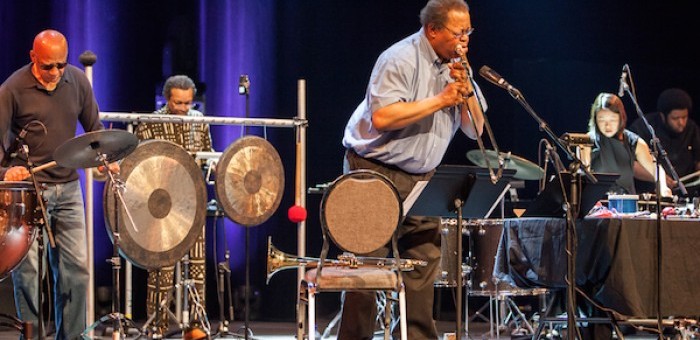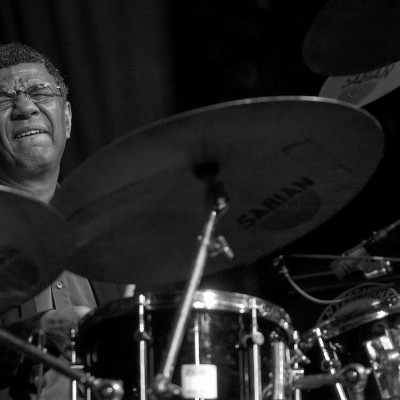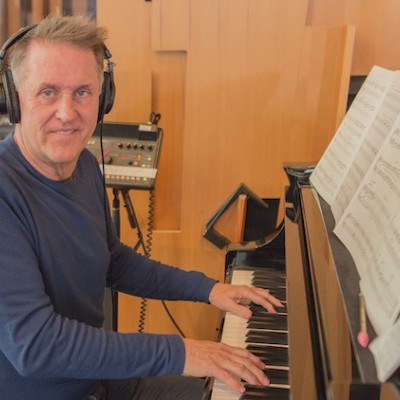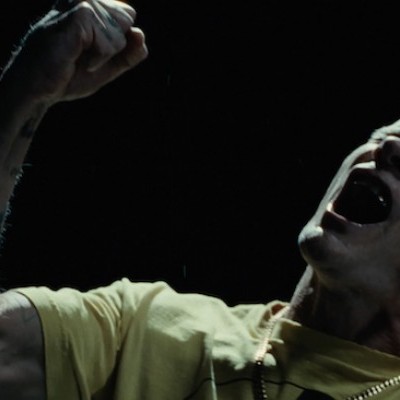Oct 28, 2025 10:47 AM
In Memoriam: Jack DeJohnette, 1942–2025
Jack DeJohnette, a bold and resourceful drummer and NEA Jazz Master who forged a unique vocabulary on the kit over his…

Thurman Barker (left), Eli Fountain, George Lewis, Aiyun Huang and Tyshawn Sorey perform at the 2016 FIMAV in Victoriaville, Canada.
(Photo: Martin Morissette)Although it is generally categorized as a jazz festival, the phenomena known as FIMAV (Festival International de Musique Actuelle de Victoriaville) is a place where musical worlds collide in a friendly, genre-broadening way.
This annual validation of experimental, improvisational and otherwise alternative musical creativity takes place during the third weekend of May, in Victoriaville, a city in the Quebec countryside dotted by idyllic dairy farms and ample outlets for poutine—the rugged, albeit caloric, Quebecois delicacy.
Not surprisingly, this is a unique, important festival destination coveted by the ultra-adventurous John Zorn, who settled on this event to stage his 60th birthday marathon, “Zorn @ 60,” back in 2013. He returned this year for a four-hour, multi-artist mini-festival around his recently-penned compendium of 300 short pieces, or “Bagatelles,” stretched out over a Saturday barnstorming session in Victoriaville.
That Zorn-centric showcase aside, the 2016 FIMAV Festival (the 32nd edition to be braved by intrepid founding director Michel Levasseur), was one of the stronger and more balanced programs in recent memory. Key events in the willfully eclectic mix included a rare Canadian visit from the pioneering improvisational group Musica Elettronica Viva (aka MEV), in its 50th anniversary year; a stellar and wowingly subtle George Lewis project called “Impromptus”; and the Swiss duo of vocalist Andreas Schaerer and drummer Lucas Niggli.
Other memorable moments along the four-night/three-day roster of 20 concerts included the deliciously bizarre midnight show from Quebec fusion act FET.NAT, with the wild man singer-poet known as JFNO vaguely recalling Pere Ubu’s charismatic leader David Thomas, and the laptop-and-mixer elegance of French artist Bérangère Maximin, who led an hour-long trip into a captivating sound world of her own deft devising.
From the Canadian/Quebecois contingent, the offerings included the Vancouver guitarist-songwriter Tony Wilson; the throat-singing improvisational spirit-channeler Tanya Tagaq; a large ensemble aggregate featuring Olivier Benoit leading the groups Ggril and Ensemble Supermusique; and a closing set by the minimalist rock outfit Big/Brave—with violinist Jessica Moss as a sound-enhancing guest.
In an especially illuminating entry in the festival’s yearly tradition of morning press conferences, MEV’s Richard Teitelbaum and Alvin Curran (the third member, Frederic Rzweski, hadn’t arrived yet), spoke of the fairly revolutionary ideas behind the semi-anarchic group’s formation in 1966, contrasting the fragmented nature of the avant-garde scene today.
Curran noted that, while the fragile, esoteric world of free improvisation has “had its ups and downs,” it’s nonetheless “here to stay.” He also asserted that, 50 years later, the MEV agenda is engaged in “music about ripping things apart.”
Those ideals translated to intriguing musical terms onstage on May 22, with the strangely working chemistry of the threesome. They produced a simultaneously disjointed yet united interplay between Rzweski’s lyrical piano parts, Teitelbaum’s playful abstractions on keyboards and Curran’s ever-changeable vocabulary.
Ironically, Curran’s use of samples—including dips into the sound banks of hip-hop and pop, along with ambient circus tricks—somehow suggested a more “old-fashioned” expressive world than that of the centuries-old grand piano. But that’s part of the MEV charm, circa 2016.
For his part in the ever-evolving dialectic of free improvisation, trombonist Lewis—last heard here in a compelling trio with Roscoe Mitchell and Muhal Richard Abrams in 2012 and in Evan Parker’s Electroacoustic Septet in 2014—handily demonstrated fresh conceptual and gestural meaning in a field that has deep historical precedents. Lewis’ “Impromptus” came to life with a group of four instrument-hopping percussionists: Tyshawn Sorey, Thurman Barker, Aiyun Huang and Eli Fountain.
As FIMAV’s long history of free improvisation outings go, this set unfolded with an uncommon taste of freedom and exploration. Structure, such as it was, came via instruction or cue-bearing cards passed around the ranks, and the prevailing spirit of taste, subtlety, restraint and ensemble sensitivity achieved that special state of grace reserved for inspired improvisational settings.
We in the audience were duly transported, momentarily forgetting that this epiphany was taking place in a transformed hockey arena in a dairy farm region in Quebec.

Jack DeJohnette boasted a musical resume that was as long as it was fearsome.
Oct 28, 2025 10:47 AM
Jack DeJohnette, a bold and resourceful drummer and NEA Jazz Master who forged a unique vocabulary on the kit over his…

Goodwin was one of the most acclaimed, successful and influential jazz musicians of his generation.
Dec 9, 2025 12:28 PM
Gordon Goodwin, an award-winning saxophonist, pianist, bandleader, composer and arranger, died Dec. 8 in Los Angeles.…

Nov 13, 2025 10:00 AM
For results of DownBeat’s 90th Annual Readers Poll, complete with feature articles from our December 2025 issue,…

Flea has returned to his first instrument — the trumpet — and assembled a dream band of jazz musicians to record a new album.
Dec 2, 2025 2:01 AM
After a nearly five-decade career as one of his generation’s defining rock bassists, Flea has returned to his first…

To see the complete list of nominations for the 2026 Grammy Awards, go to grammy.com.
Nov 11, 2025 12:35 PM
The nominations for the 2026 Grammy Awards are in, with plenty to smile about for the worlds of jazz, blues and beyond.…








